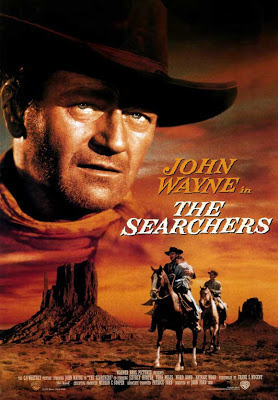Searching Out Hard Truths in "The Searchers"

When I first saw The Searchers, I was baffled. I had sought it out because such tastemakers as Steven Spielberg, George Lucas, and Martin Scorsese were proclaiming it one of Hollywood’s greatest films. By the time I watched The Searchers, I had shaken off my parents’ disdain for Westerns. I admired John Ford as a filmmaker, and knew to appreciate the iconic power of John Wayne as a leading man. Still, the filmleft me perplexed. There was, for one thing, its wildly shifting tone: stark tragedy and raucous comedy danced cheek to cheek. The Searchers (1956) also felt somehow shapeless, lacking the tightly controlled forward momentum of Ford’s 1939 prizewinner, Stagecoach. And the John Wayne of Stagecoach – a man of rough-hewn but unmistakable nobility – is not exactly the John Wayne who appears in The Searchers. As a Civil War veteran who dedicates his life to finding the young niece abducted by Comanche marauders, he definitely merits admiration. Yet he’s got a mean streak a mile wide. What was I to make of that?
Unlike me, journalist Glenn Frankel has been a fan of The Searchers since childhood. He grew up to work for the Washington Post, earning a Pulitzer Prize for his coverage of the Middle East. Perhaps his years of observing the Arab-Israeli conflict gave him a special grasp of the tensions between Indians and settlers that lie at the heart of Ford’s film. In any case, he’s earned cheers from movie history buffs with his third book, The Searchers: The Making of an American Legend. Frankel knows everything worth knowing about the conditions under which the film was made. I loved the details about shooting in Monument Valley, a Navajo tribal reserve lacking pretty much everything but gorgeous scenery: no telephones, no public water system, no electrical grid. Most of the actors camped out in a tent city for months on end; food and ice were trucked in from Utah. Ford was happy to improve the lot of local Navajos by hiring them as extras, and used a local shaman to guarantee favorable weather.
What I didn’t expect from Frankel’s book was a foray into Texas history, and an introduction to the girl whose real-life abduction by Indians inspired the movie’s plot. Cynthia Ann Parker was nine years old when she was carried off by a Comanche war band that had massacred her parents. She later married and had three children by her Comanche husband, before being recaptured by Texas Rangers twenty-four years later. Though welcomed back by family members, she never re-adjusted to the white man’s ways and apparently died a tragic figure. Her uncle James’ obsessive search for her forms of the core of John Ford’s movie.
In The Searchers, young Debbie is mostly absent. She’s the McGuffin of the film, the object of the search, without clear-cut desires of her own. As played by the young and lovely Natalie Wood, she’s almost opaque. In contrast, there’s John Wayne’s role as the tough, smart, angry, lonely Uncle Ethan. It’s part of Ford’s aesthetic to strip away most of the explanations behind Ethan’s behavior. But surely Ford is exploring the bold contradictions embedded within the frontier mentality. Says Frankel, “While The Searchers pays homage to the familiar themes of the classic Western, it also undermines them. Its central character possesses all of the manly virtues and dark charisma of the Western hero, yet is tainted by racism and crazed with revenge.” That’s what makes The Searchers so fascinating. It’s about square dances and family breakfasts and a murderous loner who’s still heroic in his own way.
Published on September 17, 2013 12:07
No comments have been added yet.
Beverly in Movieland
I write twice weekly, covering topics relating to movies, moviemaking, and growing up Hollywood-adjacent. I believe that movies can change lives, and I'm always happy to hear from readers who'd like t
I write twice weekly, covering topics relating to movies, moviemaking, and growing up Hollywood-adjacent. I believe that movies can change lives, and I'm always happy to hear from readers who'd like to discuss that point.
...more
- Beverly Gray's profile
- 10 followers



